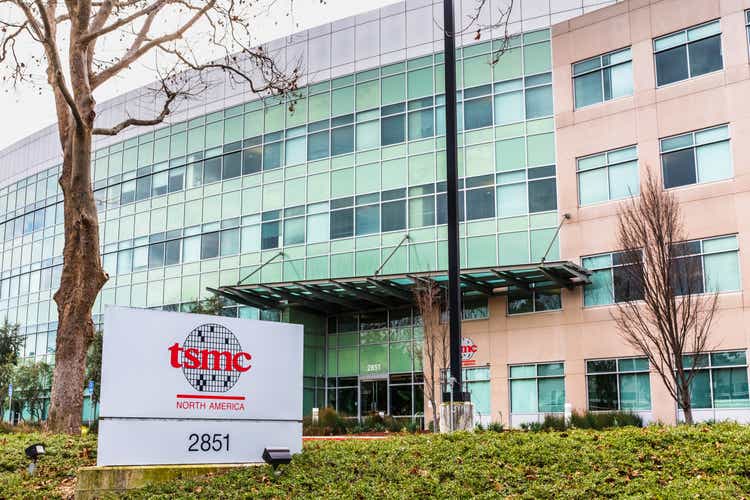
Sundry Photography/iStock Editorial via Getty Images
Taiwan Semiconductor Manufacturing’s (NYSE:TSM) stock jumped about 7% premarket on Thursday after third quarter results beat estimates and fourth quarter revenue outlook was seen above estimates, amid surging demand for AI chips.
TSM results also assuaged sentiments on AI demand, following the shock investors received after ASML’s (ASML) results two days ago.
Third quarter net revenue grew 36% year-over-year to $23.50B (NT$759.69B, +39% Y/Y). EPS per American Depositary Receipt, or ADR, was $1.94, compared to $1.29 in the third quarter of 2023. Both top and bottom line numbers surpassed analysts’ expectations. Net income grew 54.2% year-over-year to NT$325.26B.
“Our business in the third quarter was supported by strong smartphone and AI-related demand for our industry-leading 3nm and 5nm technologies,” said TSM’s Senior VP and CFO Wendell Huang.
Earnings Call and Outlook:
TSM — which produces chips for some of the world’s largest tech companies, including Apple (AAPL), Nvidia (NVDA) and AMD (AMD) — has seen a rise in demand for semiconductors used in AI applications.
“The demand is real, and I believe it’s just the beginning” said Chairman and CEO C.C. Wei, on the company’s earnings call, referring to demand on AI and noted that it would continue for many years.
Other than AI, the overall semiconductor demand has stabilized and has started to improve, according to Wei.
CFO Huang said on the earnings call that TSM now expects 2024 CapEx to be slightly higher than $30B.
Of the total, between 70% and 80% of the capital budget will be allocated for advanced process technologies. About 10% to 20% will be spent for specialty technologies and about 10% will be spent for advanced packaging, testing, mask making and others, Huang noted.
TSM expects capital expenditure to be higher in 2025 compared to this year.
CEO Wei said that TSM now forecast the revenue contribution from server AI processors to more than triple this year and account for mid-teens percentage of total revenue in 2024.
Wei added that the TSM now expects its full year revenue to increase by close to 30% (in US$).
For the fourth quarter, TSM expects revenue to be between $26.1B and $26.9B (midpoint of $26.5B), versus consensus revenue estimate of $25.02B.
“Moving into fourth quarter 2024, we expect our business to continue to be supported by strong demand for our leading-edge process technologies,” Huang noted in the company’s press release.
Facilities: TSM expects the first fab in Arizona to see volume production in 2025, while its second fab is expected to begin volume production in 2028. The company expects the third Arizona fab to start volume production by the end of the decade.
Analysts Comments:
“TSMC’s earnings have likely calmed investor fears as they navigate the recent ASML earnings fallout. AI revenue is expected to remain robust, as TSMC raised its 2024 revenue growth outlook to 30% from mid-20% previously,” said JR Research, Investing Group Leader for Ultimate Growth Investing.
Earlier this week, ASML’s third quarter bookings missed analysts’ expectations, and the company’s guidance sent shockwaves into the chip sector.
JR Research noted that ASML’s caution on non-AI related revenue is expected to dampen sentiments on other segments within the semiconductor industry.
“Investors will likely want more clarity on Apple’s AI-driven “supercycle” before returning with more conviction,” JR Research added.
“TSMC’s earnings beat was substantial. Despite the increasing mix shift towards the less profitable 3nm process node and rising electricity costs, TSMC outperformed the higher end of its 3Q gross margin guidance by more than two percentage points at 57.8%,” said Seeking Alpha Analyst Livy Investment Research.
Livy noted that this sets a strong foundation for TSM in maintaining its long-term gross margin target of 53%+, despite other emerging cost challenges which include continued N5 to N3 tooling conversion costs, and overseas fab ramp up costs.
“Most importantly, we believe TSMC’s consistent streak of margin improvements also complement its upcoming introduction of 2nm, which starts volume production next year.”
Livy added that the new process node will deliver better unit economics and a faster ramp schedule than 3nm, and is also positioned for strong adoption because of its substantial power improvements which would be required by next-generation AI processors.
“This accordingly drives incremental margin accretion for TSMC, underpinning a further uplift to the stock’s prospects,” Livy commented.
Q3 Revenue by Technology:
TSM said that 3nm process technology contributed 20% of total wafer revenue in the third quarter of 2024, versus 6% in the year ago period, and 15% in the second quarter of 2024.
The 5nm process technology accounted for 32% of total wafer revenue in the third quarter, compared to 37% in the same period a year ago, and 35% in the second quarter of 2024. Meanwhile, 7nm accounted for 17% of total wafer revenue in the third quarter versus 16% a year earlier, and 17% in the second quarter of ’24.
Advanced technologies (7nm and below) accounted for 69% of total wafer revenue.
Q3 Revenue by Platform:
High Performance Computing, or HPC, represented 51% of net revenue, versus 42% a year earlier, and 52% in the second quarter of 2023. Smartphone represented 34% of net revenue, versus 39% in the year ago period, and 33% compared to the second quarter of 2024.
Q3 Revenue by Geography:
In the third-quarter, revenue from China — the second-biggest market by revenue for TSM — accounted for 11% of the total net revenue, down from 12% in the year-ago period and 16% in the second quarter of 2024.
North America remained the largest market with 71% of total net revenue coming from it, compared to 69% a year earlier, and 65% in the second-quarter of 2024.
